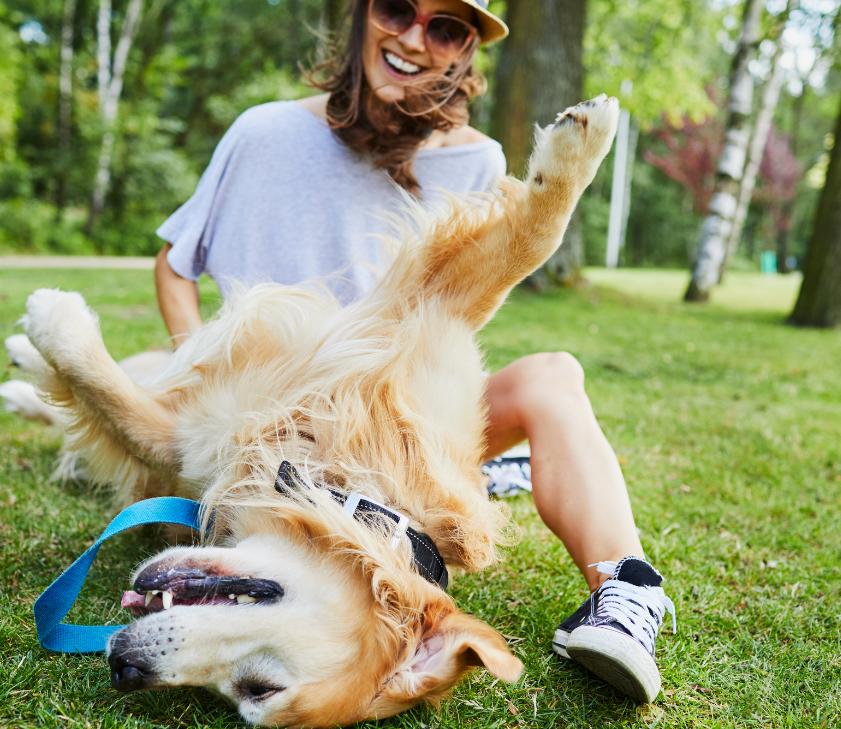You want your dog to be a social butterfly, right? Whether you’ve got a bouncy pup or a wise old hound, giving them chances to mix with humans and other furry mates is important. Perhaps you’re looking to socialise your new puppy, or perhaps you’re navigating the quirks of an older dog who’s not quite a people person.
Whether you’re out for a walk or having friends over to your home, it’s important that your pooch knows how to socialise and it’s important that you know what to look out for if your pet is feeling uncomfortable.
Understanding what’s behind any aggressive or anxious behaviour is the first step. Let’s dive into your dog’s emotional world and explore some easy dog training strategies to help them feel comfy around everyone.
Anxiety
Dogs aren’t immune to feeling the nerves – it’s just part of life. Genetics, past experiences, or even a change in their surroundings can all stir up a pot of anxiety. Here’s what to watch out for:
●Separation anxiety – this one’s a biggie. Your furry friend might go a bit bonkers when you’re out the door, with symptoms like barking up a storm or causing havoc around the house.
●Noise phobia – think thunderstorms or fireworks. Loud bangs can send your dog into a trembling, hide-and-seek frenzy.
●Social anxiety – these situations can be a bit daunting, especially if they missed out on those puppy playdates. That’s when social anxiety kicks in, making your pooch a bit jittery around other dogs and people.
●Boredom – sometimes, it’s just boredom or too much pent-up energy causing the lack of mental stimulation blues.
●Past trauma – And let’s not forget our four-legged pals who’ve had a rough start – rescue dogs can carry a lot of emotional baggage from past traumas.
Aggression
Aggression might not be your dog’s default setting, but environmental factors, learned habits and a sprinkle of anxiety can all play a role. Maybe your dog’s just trying to play bodyguard? Or perhaps they’re guarding their food or favourite spot.
Fear can trigger aggression when your pooch feels threatened or protective. Fear-based aggression can stem from your pup’s past lack of socialisation which can then make them jittery around others.
Tips for socialising your dog
As the saying goes, it’s never too late to teach an old dog new tricks. Here’s what you can do:
●Start small – gradual exposure to new things is the name of the game. Treats, praise and a bit of gentle persuasion go a long way.
●Make every social outing a positive experience. Toys, treats and lots of love can turn even the scariest situation into a walk in the park.
●Obedience training is not just for show-offs. Teaching your dog the basics like sit, stay and come can give them a confidence boost in social settings.
●Always keep an eye on playdates. If things get a bit too rowdy, step in and defuse the situation before it escalates.
●And most importantly, positivity breeds positivity. Reward those calm, friendly interactions with lots of fuss and treats.
Creating a safe vet visit
Visiting the vet doesn’t have to be a scary ordeal. Here’s how to keep it stress-free:
●Practice makes perfect! Get them used to being handled gently by practicing touching their paws, opening their mouth and looking inside their ears at home so vet check-ups feel like a breeze.
●Ensure your dog is wearing a well-fitting collar and lead to ensure they stay close to you in the waiting room. It’s important to keep you dog close to your side – away from other animals – as a vet visit can be a heightened time for everyone involved.
●Take your pet for some ‘happy vet clinic visits’. This is when you visit your local clinic to meet the team and enjoy some treats without being poked or prodded.
●Choose your vet appointment wisely – quieter times mean less waiting around and less stress for your furry friend.
●Give your vet the lowdown on your dog’s quirks and fears so they’re well-prepared.
●If your dog’s a bit of a stress head at the vet’s, chat with the staff about ways to calm their nerves.
●Be their rock during the visit – a little reassurance goes a long way.
●Follow the vet’s lead when it comes to handling your dog – they know what they’re doing.
●And last but not least, shower them with love and treats after the visit – it’s the best way to say, “Well done, buddy!”
For further information and tips on socialising or training your dog, get in touch with your vet or a trusted dog trainer.
Post time: May-12-2024

